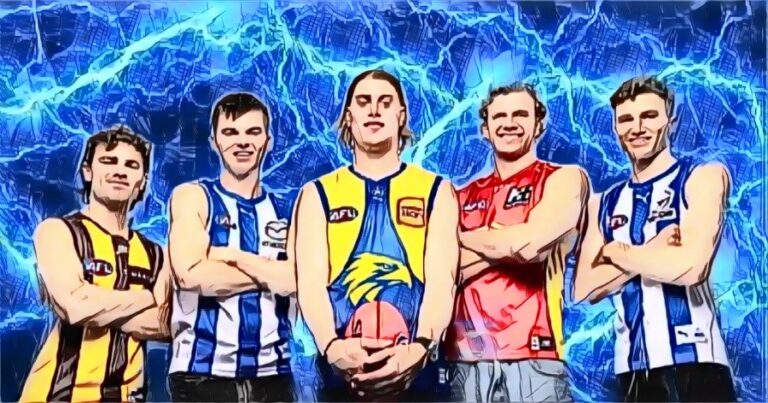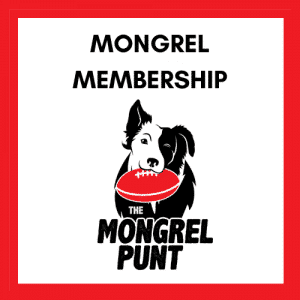Now that the National draft, the rookie draft, and the three picks that constituted the pre-season draft have been completed, we need to talk about the elephant in the room. Okay, we need to talk about the many elephants in the room – it’s like a zoo in here.
Gold Coast was able to select four players from their academy in the first 26 picks, 29 players were taken in the increasingly farcical first round, and the rookie draft became (not recently, but it’s still worth talking about) the place to send those players that are about to cash in their retirement cheques.
The AFL has tried to make its competition as equal as it can, through the implementation of academies for its Northern clubs, but has it gone too far? So, how do we fix it? How do we begin to fix a system that has become so broken it is routinely mocked for its ridiculousness? Well, with 76 players finding new homes, let me have a go.
And before we crack into it, I’ve got a lot to say about a lot of aspects of the AFL’s various draft systems, so this could go off the rails pretty quickly. Don’t say you weren’t warned.
ACADEMY PICKS
The only reason we’re talking about this at all is because Gold Coast, to their credit, it must be said, were able to develop and select four elite talents from this year’s pool, all within the top 26 selections. Jed Walter at pick three, Ethan Read at nine, Jake Rogers at 14, and Will Graham at 26. Yes, they had to match bids on each player, but when you look at what they had to give up, it becomes a little bit absurd that they were able to achieve all that they did. To match Walter, they used picks 26, 30, and 32, and got back picks 58 and 87. For Read, they used 34, 38, and 48, and got back 49. To secure Rogers, it was 42, 47, and 49, to also get 65 in return, and for Graham, it was 47 and 51, for 26 and 69.
Now when this was brought to my attention this afternoon, I lambasted the sheer ridiculousness of each of these swaps. Putting it bluntly, if these swaps were proposed between two clubs, there is a less than zero percent chance they’d be accepted. So with that in mind, how exactly were the Suns able to wheel and deal to make all this happen?
The argument can be made that this year was the outlier for the Suns, and in any other draft class, four academy selections from the one club won’t be taken in the first round alone, so why change the rules at all, but that isn’t solving the problem. It’s just putting it in the too-hard basket and hoping no one notices when it inevitably happens again, however far into the future that is.
The way to fix it is fairly straightforward. First, only one academy player can be taken by a club in each round. So, if Gold Coast drafts Jed Walter, it essentially means open slather for Read, Rogers, and Graham.
Second, no more of this ‘pick 3 is worth picks 26, 30, and 32’ nonsense.
Gold Coast knew that Walter was going to be bid on within the first three picks. So, if they wanted to draft him, they had two options. Either don’t trade out your original sixth pick to the Bulldogs, or if you DO want to do that, trade back into the first round as close to the top three as you possibly can. In this example, we assume the Suns trade their pick six out, and in all their dealings, get pick eight back for draft night. Jed Walter gets bid on at pick three, and to match it, Gold Coast uses that pick eight, as well as a pick in the second round, to match the bid, and Walter is their man.
Now, I know what you’re thinking. But Matt, what happens if Walter slides past Gold Coast’s theoretical pick eight, and the Suns draft someone else (Daniel Curtin, just as an example)? Well, since the Suns had a pick, and could’ve taken Walter if they chose, then it’s simply too bad, so sad. You had your chance, you didn’t take it, and now Walter too becomes free for any club to pounce.
And I need to make another thing clear. Everything I just said applies to the Father/Son system as well. Brisbane knew that a bid for Will Ashcroft would come at the very pointy end of the draft. So again, in order for the Lions to pick him up, they need to trade to get a pick as close as possible to the second overall selection. Only then can they pick up their star prospect. If they can only manage to get as low as pick 10, for example, they better be prepared with some low second-rounders to sweeten the deal.
I’ve seen more than a few people calling for the academies themselves to be completely abolished, and for the father-son picks to be severely culled, but for my money, I love the romanticism of a son following his father’s legacy, and as for the academies, they exist to give the Northern states more access to kids that would otherwise follow the rugby league path. In order to get more traction in the ‘non-football’ states, you need something extra that doesn’t exist in Victoria, South Australia, and Western Australia.
THE NGAS
I’m going to be completely honest here. I’m not as across the Next Generation Academies as maybe I should be. But I do recognise anger when I see it. West Coast being pissed off they couldn’t match a bid on Lance Collard. Our own Alex Docherty being furious his Dogs missed out on Luamon Lual, being taken one pick before he was eligible to be taken by his Academy club.
The only way I can see this being fixed is to treat these selections like academy picks. Collard slipped out to pick 28, so West Coast can match with their pick 30, and maybe a late fourth-rounder or something similar to bridge the gap in value between 28 and 30 (yes, I know it’s a small gap, but a pick in the 50s should be fine). Same story with Lual. Bombers bid at 39, Dogs match with 40. Easy peasy.
THE ROOKIE LIST
I’m only using this year’s rookie draft as an example, but my goodness, the rookie draft, and subsequent rookie lists have become completely absurd. Where it was once a vessel for under-developed 18-year-olds to get a go, it’s now a place to hide the over-30-year-olds you don’t want to overpay. Next year, Taylor Duryea, Sam Reid, Adam Kennedy, and Jake Melksham will all be considered ‘rookies”. As I said, absurd.
Again, how we go about fixing this one is simple. Make the rookie list for rookies. Players under 20 that have never been on an AFL list. If you delist a player, you can’t redraft them onto the rookie list. And yes, I know that seems harsh, especially for someone like Melksham, who will sit out most of 2024 with an injury, but if you commit to keeping a player around so they can rehab a long-term injury, don’t delist them. Bring in an inactive list if you must. But even that should only be reserved for long-term injuries.
And I’m also aware that capping rookie list ages at 20 means that players like Shaun Mannagh wouldn’t get selected if they were overlooked in the national draft. But that’s life sometimes. If you think they’re good enough to be on an AFL list, pick them in the draft. Don’t wait for a rookie spot.
PRE-SEASON DRAFT
No more pre-season draft. End of discussion. For Chad Wingard and Sam Day, don’t delist them in the first place. For Riley Bonner, trade for him or pick him in the national draft, just like Collingwood did with Luke Ball in 2009.
THE MID-SEASON ELEPHANT IN THE ROOM
This is the point of our journey that I warned you about. Everyone in the Mongrel chat knows that I am no fan of the mid-season draft.
No, that’s not strong enough.
I hate the mid-season draft. I loathe it. I DETEST IT.
The sooner it’s gone, the better. But why hate something so passionately that provides another vessel for state league players to get a crack at the big time while filling a hole on a club’s list?
Simple.
If push came to shove, I would consider myself an SANFL supporter above all else. And anytime it’s damaged to plump up the AFL, I feel personally affronted. Take last year as the best example. Glenelg were flying. They were marching towards another well-deserved premiership. That is, until the mid-season, and in two fell swoops, their season was derailed. Star midfielder Brett Turner was picked up by the Crows, and brilliant key defender Sam Durdin was pulled away by Carlton. Best mid, and best key back, both gone in an instant, two holes the Tigers couldn’t fill, and their quest for premiership glory couldn’t be recovered.
Luckily, this seismic destruction has yet to happen to my team, Central Districts, but that really isn’t the point. The fact that the AFL is so comfortable tearing the heart out of state league clubs just to plump up their rosters is infuriating. Sure, you can say that a club should be able to pick up a glaring need, such as a ruckman or key defender if they suffer long-term injuries that render them impotent, but my counterargument to that notion is that a list manager’s sole job is to, as the job title suggests, manage the list. If that list is depleted thanks to injuries, so be it. You didn’t do your job well enough, and you should suffer the consequences of that failure.
LIST SIZES
Now that I’ve got that out of my system, let’s dive right into another one of my peeves. With Port Adelaide and Adelaide announcing their intentions to break away from the SANFL and push ahead with a national reserves competition, it got the conversation flowing regarding the sizes of AFL lists. You see, in order for the national reserves competition to work, AFL list sizes will have to grow significantly in order to select two teams each week.
Much like the mid-season draft, this will only hurt the lower levels even more than they are already suffering. By bringing in a national reserves competition, and the 19th team in Tasmania, list sizes will have to grow out to 50+. 19 teams, each with 50 players, takes the number of AFL players out to nearly 1,000. They’ve got to come from somewhere, and I’ll give you one guess as to where those reserves players will likely come from.
I fear for the state leagues if this concept is brought in. All the best players will leave their clubs to get themselves closer to the eyes of AFL recruiters. When they are delisted, AFL players will choose to sign with AFL-affiliated clubs, rather than the clubs they were originally drafted from. Jackson Hately did exactly that. Instead of returning to Central Districts, Hately took a chance with Essendon’s VFL program, and good luck to him. But it’s examples like this that actively hurt, in this instance, the SANFL. It’s not the fault of Hately, he’s only doing what is best for his career. But it’s something that needs to be fixed. I just can’t find a solution to a problem that threatens so many of us.
STATE LEAGUES
This is turning into a vessel for my grievances against the AFL, but we’re here now, so let’s just get it all out.
I don’t know what the AFL has against its lower leagues. They seem hell-bent on destroying one of the many places their players come from. Legends like John Platten, Malcolm Blight, Craig Bradley, Matthew Pavlich, Phil Carman, Adam Cooney, and Michael O’Loughlin all plied their trade in the SANFL before making their way to the big-time. Several more came from Western Australia. West Aussies, you know who I’m referring to, I apologise for my lack of in-depth knowledge on your superstars. Polly Farmer was absolutely one of them. Aaron Sandilands is another. New South Wales, Queensland, the rich history of the Northern Territory. TASMANIA. They’ve all produced superstar after superstar.
With all of the above already said, you can now understand why I hate it when the AFL brings in rules and regulations that have no care for the state leagues, when the AFL themselves were born from a state league, slowly expanding from the VFL to become the national juggernaut we know today.
Increasing list sizes, bringing in the mid-season draft, and treating state leagues like lab rats by trialling new rules, all make the state leagues feel less than. I know deep down that this will always be the case, but it doesn’t have to be completely like this. You can draft SANFL, WAFL, VFL, and TSL players, just don’t do it during their seasons. Bring in an AFL reserves competition if you want, but make sure that whatever competition you bring in doesn’t hurt the state league. Thousands of fans still flock to suburban grounds to cheer on their heroes, and to kill this concept is simply unnecessary. A strong state league level makes the AFL stronger too. When will the higher-ups in the AFL’s boardroom learn this fairly simple concept?
…….AND BREATHE
Well, I don’t know about you, but I certainly feel better. Years of pent-up frustration have flowed out in a therapeutic fashion. I know some of these topics are only for me, and I apologise for that, but I still believe that each item flows into the next one. Fixing the method by which players make their way onto an AFL list is only the tip of the iceberg. This is a system that is completely broken, and each level is liable and affected.
The AFL can say it holds the monopoly over football in this country, and to an extent they are correct. But they also hold a responsibility to ensure the survival of the leagues below them. If they don’t, and they keep going with their plan to fully monopolise Australian Rules football in their image, it will kill hundreds, maybe even thousands of grassroots football clubs. It needs to stop. Now.
As I warned you, this piece went a little off the rails. It swayed from the topic we originally came here to discuss. But it also ignited a conversation that is worth having. A conversation that needs to happen sooner rather than later.
To Andrew Dillon and Laura Kane. Use your new positions to become agents for change. Please, for all of us who still love grassroots football.
If you enjoyed the wonderful work of Matt Oman, you could always buy him a coffee to let him know. Click the link below and give him his caffeine fix… he’s been getting a little antsy, lately.



